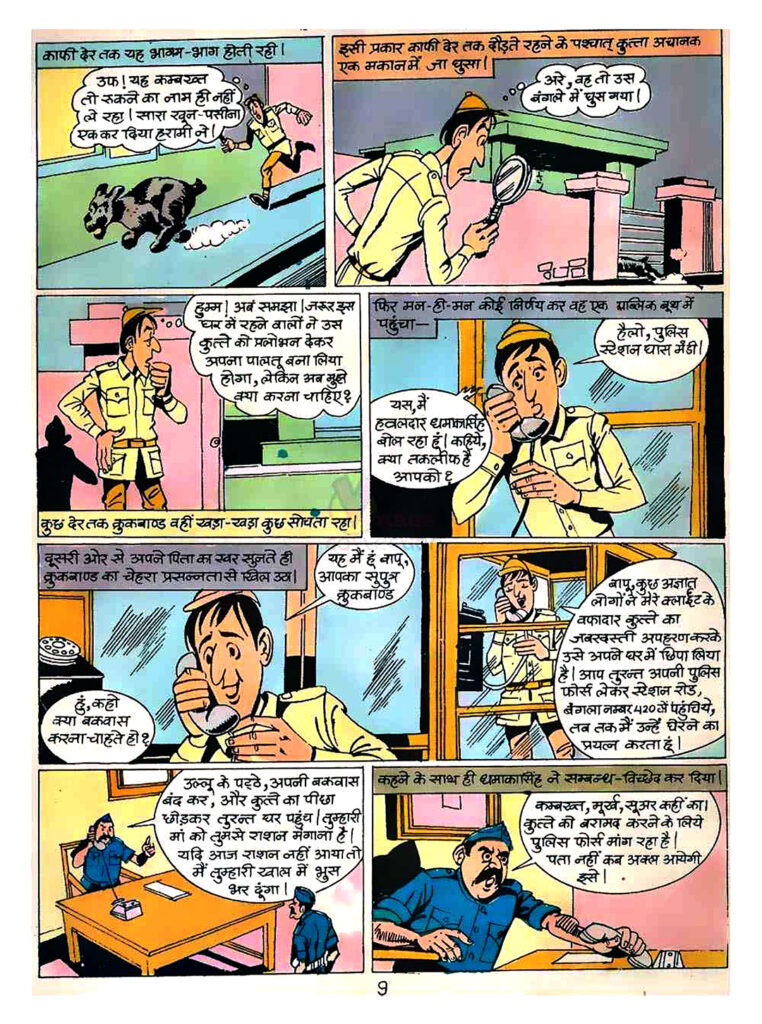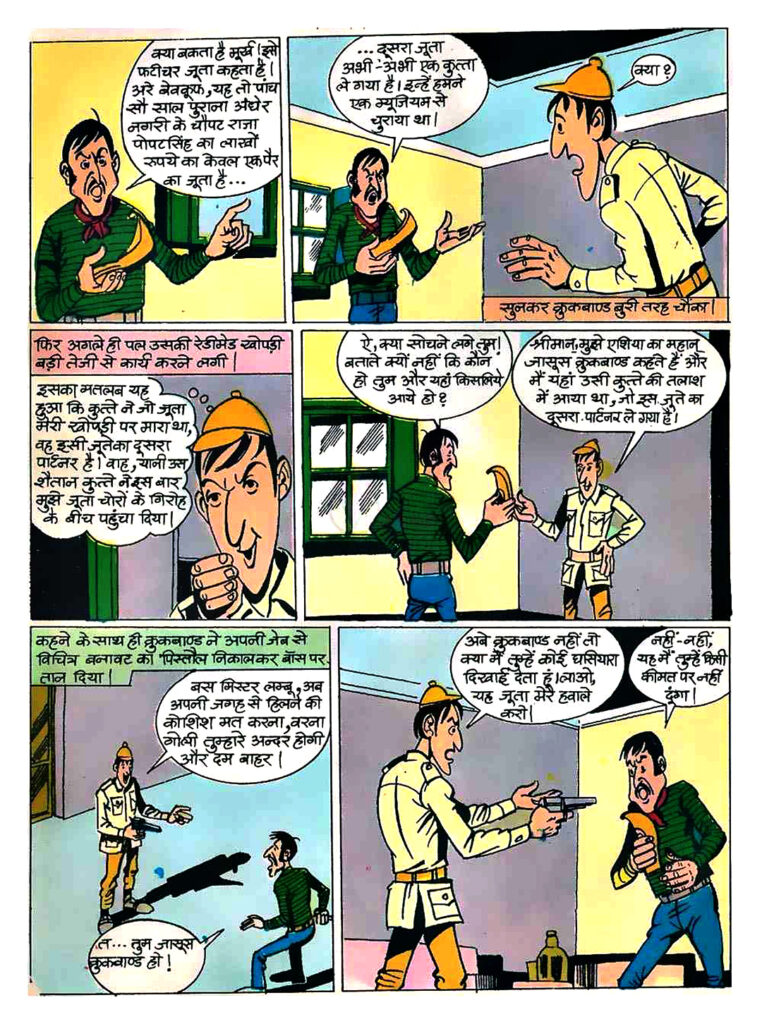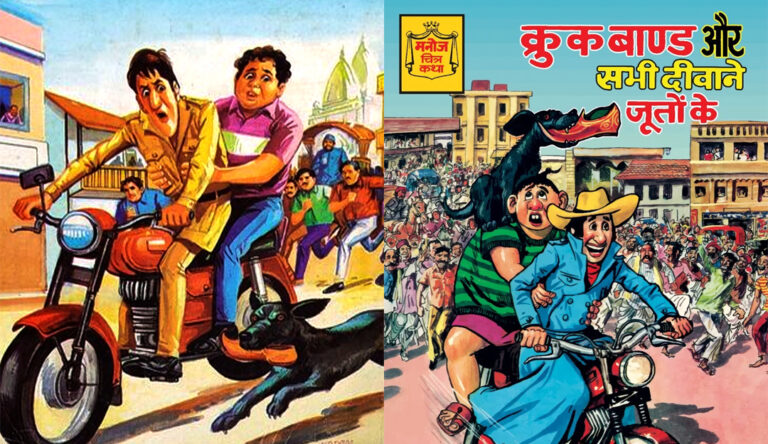Plot
The world of Indian comics has seen a golden era—a time when colorful pages filled with stories were the biggest source of entertainment for children and teenagers. While Raj Comics’ Nagraj and Super Commando Dhruv thrilled readers with their superpowers, Diamond Comics’ Chacha Chaudhary and Sabu tickled them with wit and humor. It was during this golden age that Manoj Comics carved out its own unique identity, especially with its distinctive blend of humor and espionage.
One unforgettable creation from this publishing house is ‘Crookbond’, whose real name is Anokhelal. In this review, we’ll take a deep dive into ‘Crookbond and All the Crazy Shoes’—one of the funniest and most memorable entries in the Crookbond series. Written by Bimal Chatterjee and illustrated by Trishul Comico Art, this comic is not just a delightful throwback to its era but also a shining example of the simple, intuitive, and effective storytelling style of that time.

This comic reminds us of a period when stories didn’t rely on complex psychological layers or dark realities, but on pure, unfiltered humor. Every page, every line of dialogue, and every panel transports the reader into a world where a clumsy, clueless detective manages to crack big mysteries through blunders and misunderstandings.
In this review, we’ll explore the plot, characterization, art, and humor of this comic, and also figure out why it still holds such a special place in the hearts of older readers even today.
The Essence of the Plot: A Ridiculous Tale of a Dog and Priceless Shoes
The story kicks off with our “hero,” Anokhelal a.k.a. Crookbond, who, after failing his 10th-grade exams multiple times, becomes possessed by the ghost of espionage. Accidentally catching a few petty crooks in earlier adventures makes him believe he’s a master detective. With that false confidence, he opens his own agency called “Modern Private Detective Agency.”
His cousin Motu is also there to “help,” but his only contribution is swatting flies all day.
The real story begins when Crookbond reads a headline in the newspaper:
“Mysterious theft at the museum! Five-hundred-year-old shoes of King Chaupat Raja Popatsingh of Andher Nagari, worth lakhs, stolen! Reward of Rs. 1 lakh announced.”
Crookbond immediately sets his eyes on the case. But before he can jump in, a beautiful woman named Malti walks into his office. She hires him to find her missing dog and even pays him an advance of Rs. 500. For Crookbond, who hadn’t landed a single case till now, this was like winning the lottery.
Thus begins Crookbond’s foolish mission. He roams the streets sniffing a handkerchief Malti gave him to track the dog. Along the way, he chases dozens of wrong dogs, becomes the laughingstock of bystanders, and keeps ending up empty-handed. Eventually, he comes across a black dog that leads him straight to Bungalow No. 420.

Convinced the dog has been kidnapped by the bungalow’s residents, Crookbond calls his father, Havildar Dhamaka Singh, for backup. Instead of helping, Dhamaka Singh scolds him and shoos him away.
The real twist unfolds when Crookbond sneaks into the bungalow. He discovers that this is actually the hideout of the same criminals who stole Raja Popatsingh’s priceless shoes. And all of this happens purely by accident—because he was chasing Malti’s dog! The gang had planned to smuggle the shoes abroad that very night, but thanks to Crookbond’s blunders, everything starts falling apart.
What follows is a long, hilarious chase sequence. The dog is running with the shoes, Crookbond is chasing the dog, the criminals are chasing Crookbond, and the general public is chasing everyone—completely clueless as to why these shoes are so important. The chase barrels through city streets and narrow alleys, culminating in a comical yet thrilling climax. By sheer luck and stupidity, Crookbond not only retrieves the stolen shoes but also gets the criminals arrested, once again becoming an “accidental hero” of the city.
Characterization: The Memorable Cast
The true life of this comic lies in its characters, who make the story so colorful with their quirks:
- Crookbond (Anokhelal): The hero, but one completely unlike traditional heroes. He isn’t smart, brave, or powerful. On the contrary, he’s lazy, arrogant, and utterly foolish. His idea of detective work comes only from novels and films. He loves smoking pipes, waving magnifying glasses, and talking big—but in practice, he bungles every move. Yet, his very stupidity becomes his strength, confusing criminals and inadvertently foiling their plans. Readers don’t admire him; they laugh at him—and that’s exactly the charm of this character.
- Motu (Tillu): Crookbond’s cousin and sidekick, Motu is simple and grounded, often questioning Crookbond’s ridiculous plans. He acts like the voice of reason and, in many ways, represents the reader’s perspective. Still, he always ends up getting dragged into his cousin’s antics. Their dialogues, especially the scene where Crookbond hands him a “five-for-five-hundred” rupee note, are some of the funniest in the comic.
- Havildar Dhamaka Singh: Crookbond’s father, a stern and honest police sergeant, constantly frustrated by his son’s obsession with detective work. He wants Anokhelal to study and get a real job. Their father-son banter is both relatable and hilarious—especially when Crookbond accidentally does something heroic and his father’s anger slowly turns into pride.
- The Villains: Far from being threatening, these criminals are perpetually flustered by Crookbond’s blunders. Their rage, exasperation, and constant “facepalming” at his antics become a running source of comedy. They are vital in pushing the story forward while also amplifying its humor.
Humor and Satire: The Soul of the Comic
The biggest strength of this story is its humor, which works at multiple levels:
- Situational Comedy: The sheer absurdity of a detective chasing dogs, criminals chasing the detective, and the whole public chasing shoes is comedy gold. The author builds these scenes with perfect timing.
- Dialogue Humor: The witty exchanges between Crookbond, Motu, and Dhamaka Singh sparkle with humor. Crookbond’s bragging, Motu’s innocence, and Dhamaka Singh’s scolding never fail to make the reader laugh.
- Character Humor: Crookbond himself is a walking comedy machine. The massive gap between his confidence and actual ability makes him endlessly funny. He thinks he’s James Bond but ends up behaving like a clown.
- Social Satire: There’s subtle satire too—the mention of “Andher Nagari, Chaupat Raja” and the public blindly running after each other mirrors society’s herd mentality.
Art and Illustration: The Visual Flavor

The artwork by Trishul Comico Art perfectly complements the tone of the comic. The style is simple, clear, and vibrant—ideal for humor. The exaggerated expressions, especially Crookbond’s silly confidence, Dhamaka Singh’s rage, and Motu’s constant confusion, are drawn brilliantly. The chase scenes, particularly the climax, are full of energy and movement, keeping readers hooked. The bright, lively colors reflect the era and enhance the light-hearted nature of the story.
Conclusion
‘Crookbond and All the Crazy Shoes’ is one of Manoj Comics’ finest gems—still fresh and entertaining even after decades. It represents not just a comic but an era when stories were made with one simple goal: to entertain.
Bimal Chatterjee’s writing is sharp and witty, while Trishul Comico Art’s illustrations bring every gag and chase scene to life.
Through Crookbond, we learn that being a hero doesn’t always require powers or intelligence—sometimes luck and foolishness can do the job just as well. For older readers, this comic is a pure nostalgia trip; for the younger generation, it’s a chance to experience how wonderfully diverse and entertaining the world of Indian comics once was.
In short, it’s a must-read for every comic lover—guaranteed to leave you laughing out loud.

1 Comment
Your point of view caught my eye and was very interesting. Thanks. I have a question for you. https://www.binance.info/register?ref=IHJUI7TF